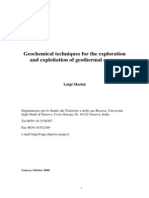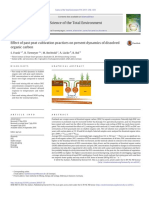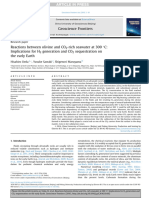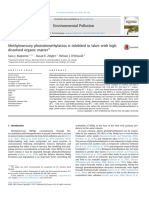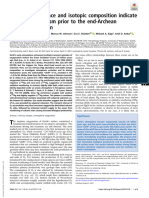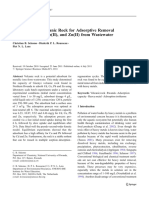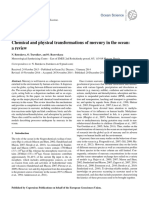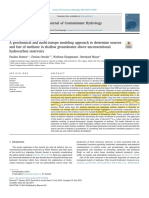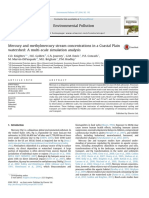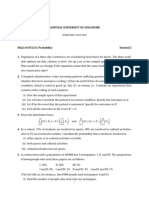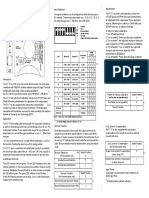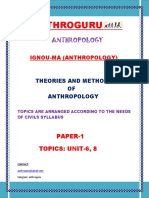Klein - Tarnas - Bach - 2020 - Abiotic Sources of Molecular Hydrogen On Earth
Klein - Tarnas - Bach - 2020 - Abiotic Sources of Molecular Hydrogen On Earth
Uploaded by
Carolina PazCopyright:
Available Formats
Klein - Tarnas - Bach - 2020 - Abiotic Sources of Molecular Hydrogen On Earth
Klein - Tarnas - Bach - 2020 - Abiotic Sources of Molecular Hydrogen On Earth
Uploaded by
Carolina PazOriginal Title
Copyright
Available Formats
Share this document
Did you find this document useful?
Is this content inappropriate?
Copyright:
Available Formats
Klein - Tarnas - Bach - 2020 - Abiotic Sources of Molecular Hydrogen On Earth
Klein - Tarnas - Bach - 2020 - Abiotic Sources of Molecular Hydrogen On Earth
Uploaded by
Carolina PazCopyright:
Available Formats
See discussions, stats, and author profiles for this publication at: https://www.researchgate.
net/publication/339687849
Abiotic Sources of Molecular Hydrogen on Earth
Article in Elements · March 2020
DOI: 10.2138/gselements.16.1.19
CITATIONS READS
47 350
3 authors, including:
Jesse Tarnas Wolfgang Bach
NASA Universität Bremen
46 PUBLICATIONS 447 CITATIONS 491 PUBLICATIONS 12,993 CITATIONS
SEE PROFILE SEE PROFILE
Some of the authors of this publication are also working on these related projects:
Submarine hydrothermal vents and base-metal sulfide deposits View project
HYDROTHERMADEC - Geochemical and ecological impacts of hydrothermal processes at intra-oceanic island arcs, using the example of the Kermadec Arc View project
All content following this page was uploaded by Wolfgang Bach on 18 May 2021.
The user has requested enhancement of the downloaded file.
Abiotic Sources of Molecular
Hydrogen on Earth
Frieder Klein1, Jesse D. Tarnas2, and Wolfgang Bach3
1811-5209/20/0016-019$2.50 DOI: 10.2138/gselements.16.1.19
T
he capacity for molecular hydrogen (H2 ) to hydrogenate oxygen and as in Hawai‘i (USA), where H 2
carbon is critical to the origin of life and represents the basis for all was identified spectroscopically
and estimated to constitute up
known life-forms. Major sources of H2 that strictly involve nonbiological to 1.8 mol% of the volcanic
processes and inorganic reactants include (1) the reduction of water during gas (Cruikshank et al. 1973).
the oxidation of iron in minerals, (2) water splitting due to radioactive decay, Giggenbach (1987) analyzed
fumarolic gases from White
(3) degassing of magma at low pressures, and (4) the reaction of water with Island (New Zealand) and found
surface radicals during mechanical breaking of silicate rocks. None of these that redox conditions and H 2 /H2O
processes seem to significantly affect the current global atmospheric budget ratios are governed by the SO2 –H2S
equilibrium during degassing from
of H2 , yet there is substantial H2 cycling in a wide range of Earth’s subsurface
the underlying magma. Studies of
environments, with multifaceted implications for microbial ecosystems. volcanic gas plumes at Mt. Etna
Keywords : molecular hydrogen, volcanic degassing, hydrothermal alteration, (Italy) and at the phonolitic lava
radiolysis, rock comminution lake at Mt. Erebus (Antarctica)
show a strong correlation of SO2
ABIOTIC SOURCES OF H2 ON EARTH with H 2 concentrations (Fig. 2),
supporting Giggenbach’s findings for White Island gases
Major sources of H2 in the lowest layer of Earth’s atmosphere (Aiuppa et al. 2011; Moussallam et al. 2012).
(i.e., the troposphere) include the photochemical oxida-
tion of CH4 and other simple organic carbon compounds Pressure is a significant control on magmatic H 2 degassing,
(1.98 × 1013 mol y−1), anthropogenic emissions from burning because at low pressure sulfur partitions more strongly into
fossil fuel and biomass (1.54 × 1013 mol y−1), and biological the vapor phase and the equilibrium
N2 fixation (2.98 × 1012 mol y−1) (Ehhalt and Rohrer 2009). 2H O + H S = SO + 3H (1)
2 2 2 2
For comparison, Worman (2015) estimates a flux of up
13
to 1 × 10 moles of abiotic H2 from submarine geologic is shifted to the right (Gaillard et al. 2011) (Fig. 2A). At Mt.
sources to the ocean per year globally. However, much of Etna, the low pressures of degassing led to a high time-
the H2 generated in marine settings is consumed at depth averaged H2 flux of 3.2 × 10 8 mol y−1 (Aiuppa et al. 2011).
and never reaches the atmosphere, suggesting substantial In submarine settings, magmatic degassing occurs at higher
H2 cycling in the deep ocean and subseafloor. Abiotic H2 pressures and should release little H2 (Gaillard et al. 2011).
has been detected in a broad array of subaerial and subma- Indeed, highly vesicular mid-ocean ridge basalt (MORB)
rine environments, including oceanic spreading centers, “popping rocks” from the Mid-Atlantic Ridge (which can
transform faults, passive margins, convergent margins, and explode upon decompression during sample recovery) have
intraplate settings. The main geologic sources responsible low H2 contents in the CO2 -dominated gas phase.
for H2 formation and the estimated annual fluxes per source
are summarized in Figure 1 and discussed in the following Holloway and O’Day (2000) argued for H2 release to the
sections. Processes that do not lead to H2 emanations at ocean during MORB crystallization because the ferric iron
Earth’s surface are not discussed. content of crystalline MORB is significantly higher than
that of MORB glass. Crystallization of MORB magma may
Magmatic H2 generate as much as 6.3 × 1012 mol H 2 y−1 globally, which
would exceed the annual MORB CO2 production (Holloway
Emission of magmatic gases containing H2 can be observed
and O’Day 2000). High H2 concentrations of hydrothermal
during, or immediately after, a volcanic eruption, such
vent fluids in the aftermath of volcanic events may support
the idea of transiently high H2 fluxes in ridge crest environ-
1 Woods Hole Oceanographic Institution ments, but such excursions may be due to hydrothermal
Department of Marine Chemistry and Geochemistry fluid–rock interactions (see below) rather than magmatic
266 Woods Hole Rd, MS# 8
processes (Lilley et al. 2003). For this reason, H2 produc-
Woods Hole, MA 02543, USA
E-mail: fklein@whoi.edu tion from submarine volcanism remains speculative and
2 Brown University requires further study.
Department of Earth, Environmental and Planetary Sciences
Globally, the amount of H2 emitted from subaerial volca-
324 Brook St., Box 1846
Providence, RI 02912, USA noes is on the order of 4.96 × 10 9 mol y−1 (Moussallam et
E-mail: jesse_tarnas@brown.edu al. 2012). Although this seems trivial in comparison with
3 University of Bremen the global annual tropospheric H2 flux of ~3.82 × 1013 mol
MARUM and Geoscience Department
Klagenfurter Str. 2, 28359 Bremen, Germany
E-mail: wbach@marum.de
E lements , V ol . 16, pp. 19–24 19 F ebruary 2020
Downloaded from https://pubs.geoscienceworld.org/msa/elements/article-pdf/16/1/19/4960693/gselements-16-1-19.pdf
by Brown University user
Serpentinization
Radiolysis α, β,γ Mechanoradicals
,K At slow and ultraslow spreading mid-ocean ridges with
H2O U , Th
limited magma supply, peridotite can be the most abundant
e- rock type to host hydrothermal circulation. The hydro-
H2O* H2O+ thermal alteration of peridotite (serpentinization) causes
H 2O H 2O
- a series of interrelated dissolution–precipitation and redox
H● +HO● HO● + H3O+ e aq reactions and the formation of H2 . Olivine and orthopy-
... roxene, the most abundant minerals of peridotite, are
H2 (H2O, H2O2, O2) 2(≡Si) + 2H2O → 2(≡SiOH) + H2 unstable under hydrothermal conditions. Their dissolution
4.7 × 1010 mol a-1 facilitates the precipitation of serpentine and magnetite,
which are central to the formation of H2 during serpentini-
Volcanic Degassing Hydrothermal alteration zation, as illustrated in the generalized E quation (3). Other
ferric iron–bearing secondary minerals found in serpen-
H2S + 2H2O = SO2 + 3 H2 tinite (e.g., chlorite, ferrichromite, and, less frequently,
andradite) play a minor role in the formation of H2 but
can become important under specific geochemical condi-
tions. Whereas these secondary minerals can contribute
SO42-(melt) + 2FeO(melt) 2FeO + H2O = Fe2O3 + H2 to the formation of H2, the Fe(II) components of brucite
= SO2(gas) + Fe2O3(melt) + O2- FeS + H2S = FeS2 + H2 and serpentine effectively limit the generation of H2 . In
this respect, it is important to note that the Fe(II) content
4.96 × 109 mol a-1 1012 mol a-1 of brucite formed during serpentinization increases with
decreasing temperature chiefly at the expense of magne-
F igure 1 Schematic representation of the main geologic tite: as a result, equilibrium H2(aq) activities decrease with
sources of abiotic H2 and their respective estimated decreasing temperature from a maximum value at ~320 °C
annual fluxes. (U pper Left) Radiolysis produces H2 during dissocia-
tion of water through radioactive decay (via alpha, beta, or gamma
at 50 MPa (Fig. 3). At higher temperatures, olivine is part
radiation). (U pper R ight) Mechanoradical reactions generate H2 on of the equilibrium mineral assemblage, which limits the
wet surfaces of active faults. Note that no estimate exists for the amount of Fe(II) available for H2(aq) generation.
annual flux of H2 via this process. (Lower Left) Volcanoes emit H2
when SO2 degasses at low pressure. (Lower R ight) Hydrous altera-
tion of rocks generates H2 if water is reduced during the oxidation
of ferrous to ferric iron. The formation of pyrite (FeS2) releases H2 in
hydrothermal reactions between water and rocks with magmatic
sulfides such as pyrrhotite (nominally FeS).
Mole fraction (gas phase)
0.01 0.1 1.0
0.1 3 10
(Ehhalt and Rohrer 2009), volcanic H2 emissions may still
be locally important to hydrogenotrophic microorganisms
in (sub)surface environments.
Degassing pressure (MPa)
S2
Hydrothermal H2 1 33 100
H2
Depth (m)
Large-scale abiotic H2 formation is evident in hydrothermal
S
systems and from hydrothermally altered rocks in a wide
range of submarine settings, including mid-ocean ridges
and back-arc spreading centers, ridge flanks, transform H2
10 333 1,000
O
CO
CO
faults, fracture zones, subduction zones, passive margins, H2
2
and intraplate hotspots. Most of our current knowledge
2
SO
about submarine hydrothermal systems comes from
mid-ocean ridges. Driven by gradients in temperature and
pressure, seawater enters the oceanic basement, percolates 100 3,33310,000
deeper into the hot but cooling igneous rocks, increases 3
its own temperature and then buoyantly rises back to the
seafloor. Once free oxygen is consumed during percola-
tion of water through rocks in the recharge zone, e.g., via 2
H2 [ppm]
iron oxidation
2 FeO + 0.5 O2(aq) = Fe2O3 (2)
1
then the oxidation of iron by oxygen-depleted water in
the root zone of a hydrothermal system can generate H2
as follows: 0
2 FeO + H2O = Fe2O3 + H2(aq) (3) 20 40 60 80 100 120 140 160 180 200
SO2 [ppm]
In this generalized reaction, FeO and Fe 2 O3 represent
the ferrous and ferric iron components in reactant and (U pper) Calculated compositions of volatiles in degas-
F igure 2
products minerals, respectively. Large parts of the oceanic sing magma as a function of pressure. Degassing at
lithosphere are composed of rocks with abundant ferrous high pressure favors CO2, CO, H2O, H2S, and S2 (in order of
decreasing abundance), whereas degassing at lower pressures
iron–bearing minerals that are prone to oxidation by
favors H2O, CO2, H2, and SO2. Note the two distinct depth scales
seawater. This process is surprisingly complex because for lithostatic pressure (brown: density is ~3 g/cm3) and hydrostatic
iron distribution during hydrothermal alteration involves pressure (blue: density is ~ 1 g/cm3). Modified from Gaillard et al.
several Mg–Fe minerals (having solid solutions), and their (2011) with permission from Springer Nature. (Lower) Graph of H2
(ppm) at Mt. Etna (Italy) showing linear correlation with SO2
compositions vary with temperature, protolith rock compo-
(ppm). Modified from A iuppa et al. (2011) with permission from John
sition, and water-to-rock ratio. Wiley and Sons.
E lements 20 F ebruary 2020
Downloaded from https://pubs.geoscienceworld.org/msa/elements/article-pdf/16/1/19/4960693/gselements-16-1-19.pdf
by Brown University user
350 ocean–continent transition zone; geophysical constraints
suggest that the uppermost 2 km are strongly to completely
serpentinized, with more limited serpentinization at greater
300
depths (Skelton et al. 2005). Considering that serpentiniza-
tion chiefly took place at temperatures lower than ~200 °C,
250 where H 2 yields are 100 to 150 mmol H2 per kg perido-
tite (Fig. 3), complete serpentinization of 40,000 km3 of
peridotite would release approximately 1–2 × 1016 mol H 2 .
H2(aq) mmol/kg
1.0
200 Skelton et al. (2005) suggest it took only 105 to 106 years to
0.95 serpentinize much of the ocean–continent transition zone
during the late stage of continental breakup, which would
150
yield a H2 production rate of 1 × 1010 to 2 × 1011 mol y−1
XMg Brucite
0.90
at the Iberian margin. Other magma-poor passive margins
100 0.85 in North America, Africa, and Australia probably produced
similar amounts of H2 over similarly short timescales. It
0.80 appears that, during the finite timespan of active serpen-
50 tinization at magma-poor passive margins, these systems
0.75 may rival mid-ocean ridges in their annual H2 output.
0 0.70 Subduction zone forearcs represent a major geologic setting
50 100 150 200 250 300 350 400 where aqueous fluids interact with mantle peridotite on a
Temperature °C large scale. Water released from sediments and from the
hydrothermally altered igneous rocks of the subducting
Predicted concentration of H2(aq) (solid line) and XMg oceanic slab can infiltrate and serpentinize the overriding
F igure 3
(molar Mg/(Mg + Fe)) of brucite (dashed line) as a forearc mantle (Fryer 2012). The resulting serpenti-
function of temperature for the serpentinization of lherzolite at nite buoyantly rises to the seafloor where it extrudes to
50 MPa and a water-to-rock mass ratio of 1, assuming thermody-
form serpentinite mud volcanoes. Because of the shallow
namic equilibrium. As temperature decreases, the ferrous iron
content of brucite increases, which limits the amount of H2 forma- geotherms and continuous water supply from subducting
tion. Modified from K lein et al. (2013) with permission from Elsevier. slabs, serpentinization can extend to much greater depths
(>>10 km) than at mid-ocean ridges. The H2 flux from the
forearc mantle directly depends on the water flux from the
subducting slab. For instance, in the Mariana subduction
In ridge-crest environments, serpentinite is usually rich
zone, the water flux from the subducting Pacific slab to the
in magnetite, indicative of high-temperature serpentini-
forearc is estimated to be on the order of 3.1 × 10 9 mol y−1
zation, strongly reducing conditions (Klein et al. 2013),
per kilometer of trench (Ribeiro and Lee 2017). Because
and sustained heat supply from cooling igneous rocks
complete serpentinization of 100 g of olivine-rich harzbur-
near the ridge axis. Where peridotite undergoes serpen-
gite consumes about 13 g water, the maximum amount of
tinization at temperatures lower than ~200 °C, magnetite
peridotite undergoing serpentinization per kilometer of
is present only in minor amounts, which is reflected in
the Mariana Trench is 43 × 1010 g peridotite, which would
the lower magnetic susceptibility of the altered rock. Yet,
generate 1.59 × 10 8 mol H 2 . Over the entire length of the
magnetite-poor serpentinites can become as oxidized as
Mariana Trench (2,542 km) about 4 × 1011 mol would be
their magnetite-rich counterparts because ferric iron can
generated per year. Although it is not likely that all of the
precipitate as a component of serpentine minerals, rather
water expelled from the slab is used up by serpentinization,
than magnetite. At low temperatures, serpentine is, there-
H2 production at forearcs appears to be comparable to other
fore, vital to the formation of H2 .
major settings. If only 10% of the water expelled from the
Concentrations of H 2 in fluids that emanate from slab at forearc depths is used to serpentinize peridotite, the
dominantly serpentinite-hosted ridge crest hydrothermal Mariana forearc alone would generate as much as 25% of
systems can be as high as 10–20 mmol kg−1, which is the global H2 production at mid-ocean ridges.
about 107 times higher than in seawater. Recent estimates
Serpentinized rocks are also widespread on land in green-
of the global annual H2 flux from serpentinization range
stone belts, ophiolites, metamorphic rocks exhumed from
from 1011 to 1012 mol y−1 for mid-ocean ridges alone (e.g.,
subduction zones, layered intrusions, and diatremes. This
Worman et al. 2016). Considering that serpentinization
in itself implies that H2 has been generated in a broad array
at mid-ocean ridges has been going on throughout most
of geologic settings since the Archean. Several ophiolites
of Earth’s history, the mass of H2 generated is enormous.
show evidence of ongoing H2 generation at low tempera-
Away from the ridge axis, hydrothermal alteration of tures. In addition to serpentinization of primary minerals,
peridotite can occur at lower temperatures and, presum- which likely proceeds at slow rates, silication and the atten-
ably, at slower rates. Yet, the temperate off-axis Lost City dant oxidation of more reactive secondary phases, such
Hydrothermal Vent Field (Mid-Atlantic Ridge) vents fluids as Fe-bearing brucite, can contribute to the generation
that have concentrations of H2 as high as those operating of H 2 (Miller et al. 2017). Sherwood Lollar et al. (2014)
at the higher temperatures typical of vents closer to the estimate an annual H2 production of 2–18 × 1010 mol y−1
ridge axis. As serpentinite moves farther off-axis through from fluid–rock interactions in the Precambrian conti-
seafloor spreading, the remaining ferrous iron can undergo nental lithosphere; however, this estimate is not limited
complete oxidation, which generates additional H2 if perco- to serpentinization because it includes alteration of other
lating water is oxygen-depleted. rock types.
Temperate serpentinization systems also exist in other Klein et al. (2019) examined serpentinization processes
geologic settings where peridotite is in contact with perco- within olivine-hosted secondary fluid inclusions. Alteration
lating aqueous fluids, such as magma-poor passive margins, of the olivine host by trapped water within a fluid inclusion
forearc settings of subduction zones, and ophiolites. At leads to the formation of serpentine, brucite, magnetite,
the Iberian Margin (off the coast of Portugal and Spain), and H 2 . This process creates conditions conducive to the
serpentinized peridotite makes up ~20,000 km 2 in the reduction of dissolved carbon, which generates abiotic CH4
E lements 21 F ebruary 2020
Downloaded from https://pubs.geoscienceworld.org/msa/elements/article-pdf/16/1/19/4960693/gselements-16-1-19.pdf
by Brown University user
inside the inclusions (Klein et al. 2019). Methane and H 2 0
can be stored within inclusions over geological timescales Sully
ydrite
until they are released by dissolution or fracturing of the Dante
ite anh
epidote
olivine host. Because such fluid inclusions can form in any Bastille
–1 Pyrite Hulk
olivine-bearing rock type, H2 generation by serpentiniza- Pyrrhotite
anorth
Puffer
tion is likely more widespread than is currently perceived.
MEF
log aH2S(aq)
Sea Cliff
H2 in Mafic-Hosted Hydrothermal Systems –2 Lucky Strike
In ridge segments with robust magma supply, hydro-
MARK-1/2
thermal systems are usually hosted in mafic (basaltic or Piccard
gabbroic) rocks. Most mafic-hosted hydrothermal systems TAG
vent fluids with H 2 concentrations of ~0.05 to ~1 mM, –3 Hematite Edmond
similar to H 2 concentrations measured during basalt–
Magnetite
seawater hydrothermal laboratory experiments. Seyfried
and Ding (1995) proposed a four-step model to explain the
formation and subsequent buffering of H2 in mafic-hosted –4
hydrothermal systems. The first stage, during which H2 is
produced, involves the oxidation of primary iron sulfide
(pyrrhotite) and the iron (fayalite) component of olivine in
gabbro under relatively low water-to-rock mass ratios. The –5
–6 –5 –4 –3 –2 –1 0
fluid then evolves toward less reducing conditions where log aH2(aq)
H2(aq) and H 2 S (aq) activities are controlled by the mineral
assemblages pyrite–pyrrhotite–magnetite (stage 2), pyrite– F igure 4 Activity–activity diagram for H2(aq) and H2S (aq) illus-
magnetite (stage 3), and anhydrite–anorthite–clinozo- trating the stability fields of the minerals hematite,
magnetite, pyrite, and pyrrhotite at 400 °C and 50 MPa. Also shown
isite–pyrite–magnetite (stage 4). Figure 4 depicts measured
are measured compositions of vent fluids emanating from mafic-
H2(aq) and H2 S (aq) concentrations (activity coefficients are hosted hydrothermal systems. Activity coefficients of H2(aq) and
assumed to be close to unity) in vent fluids emanating H2S (aq) were assumed to be close to unity. Fluid analyses from
from mafic-hosted seafloor hydrothermal systems in the hydrothermal systems that experienced magmatic events are not
included. Most fluid compositions fall on the metastable extension
system Fe–O–S, which includes the minerals pyrrhotite,
of the pyrite–pyrrhotite equilibrium (thick dashed black line)
pyrite, magnetite, and hematite. Also shown are the H2(aq) suggesting that this assemblage controls the concentration of H2(aq)
and H2S (aq) activities controlled by the mineral assemblages in mafic-hosted vent fluids. The predicted H2(aq) and H2S (aq) activi-
of anhydrite–anorthite–clinozoisite and pyrite–pyrrhotite, ties corresponding to the assemblage anorthite–anhydrite–clinozo-
isite (epidote) are shown for comparison (gray dashed line). Phase
through the following reactions:
separated fluids emanating from the deepest known mafic-hosted
3CaAl2 Si2O8 (anorthite) + CaSO4 (anhydrite) + 4 H2(aq) hydrothermal system (Piccard) cooled from higher temperatures to
the venting temperature of 397 °C and appear to have equilibrated
= 2Ca 2Al3Si3O12 (OH) (clinozoisite) + 2H2O + H2 S (aq) (4) with the assemblage magnetite–pyrrhotite. Locations of vents as
follows: the Sully, Dante, Bastille, Hulk, and Puffer vents are all in
FeS (pyrrhotite) + H2 S (aq) = FeS2 (pyrite) + H2(aq) (5) the Main Endeavour Field, Juan de Fuca Ridge, northeast Pacific
Ocean; MEF = Main Endeavour Field; Sea Cliff vent (Gorda Ridge,
There is a remarkable spread in the H 2(aq) and H 2 S (aq) off west coast of California and Oregon); Lucky Strike and
MARK-1/2 vents from the Mid-Atlantic Ridge; Piccard (Beebe
concentrations of vent fluids. Differences in temperature
Hydrothermal Vent Field in the Mid-Cayman Spreading Centre);
and pressure in the root zone of hydrothermal systems— TAG (Trans-Atlantic Geotraverse on the Mid Atlantic Ridge);
and other effects like phase separation, cooling, and Edmond vent (Central Indian Ridge). Fluid data from L illey et al.
mineral precipitation—influence the compositions of vent (2003), Seewald et al. (2003), and McD ermott et al. (2018).
fluids. Cooling of hydrothermal fluid can generate H2 at
the expense of H2 S (McDermott et al. 2018) through the
reaction
favored (McDermott et al. 2018). While this process can
Fe ++ + 2H2 S = FeS2 + 2H + + H2(aq) (6) lead to significant H 2 enrichments in the vapor phase,
the H 2(aq) and H2 S (aq) concentrations at Piccard (red stars
However, most fluid compositions fall close to the in Fig. 4) may be controlled by the equilibrium between
metastable extension of pyrite–pyrrhotite equilibrium. If magnetite and pyrrhotite during cooling. In contrast, some
the assemblage anhydrite–anorthite–clinozoisite–pyrite– vent fluids show strong, apparently unbuffered, excursions
magnetite regulates H2(aq) and H 2 S (aq) activities in mafic- in H2(aq) and H2S (aq) related to magmatic events, such as the
hosted hydrothermal systems, then the H2 S (aq) -rich fluids ‘A’ vent on the East Pacific Rise. Hydrogen was likely formed
should have lower H 2(aq) concentrations and vice versa. during fluid–rock interaction at high temperatures, but
This supports the idea that the reaction of pyrrhotite with fluids did not have time to equilibrate with either magne-
H2 S (aq) to form pyrite can generate and control H2(aq) in tite, pyrrhotite, or pyrite before venting at the seafloor.
mafic-hosted hydrothermal systems. Because the pyrite– Note that fluid compositions from ‘A’ vent were omitted
pyrrhotite equilibrium is sensitive to temperature, the from Figure 4 for the sake of clarity.
strong correlation between H2(aq) and H 2 S (aq) would also
The estimated annual H 2 production from high-temper-
suggest that these species last equilibrated with pyrite and
ature basalt alteration along the global mid-ocean ridge
pyrrhotite at ~400 °C.
system is 0.4–6 × 1010 mol y−1, with a preferred value of
In contrast to most of the fluid compositions that are consis- 3 × 1010 mol y−1 (Worman 2015). These annual production
tent with the (metastable) pyrite–pyrrhotite equilibrium, rates were estimated by applying a H 2 concentration of
the composition of fluids from the Piccard Hydrothermal ~2 mM that is controlled by the quartz–fayalite–magnetite
Vent Field (also known as the Beebe Hydrothermal Vent (QFM) equilibrium to an annual flux of high-temperature
Field) on the Mid-Cayman Rise fall close to the magne- hydrothermal fluids (1013 kg) through the global mid-ocean
tite–pyrrhotite equilibrium (Fig. 4). There is evidence ridge system. Although a concentration of 2 mM or less
for phase separation at Piccard at temperatures >>491 °C is reasonable, we emphasize that QFM only serves as a
where volatile partitioning into the vapor phase is strongly theoretical approximation. Much of the H 2 generated
E lements 22 F ebruary 2020
Downloaded from https://pubs.geoscienceworld.org/msa/elements/article-pdf/16/1/19/4960693/gselements-16-1-19.pdf
by Brown University user
during basalt alteration is controlled by the (metastable) breakage (e.g., LaVerne and Tandon 2005). These reactions
equilibrium between pyrite and pyrrhotite (E qn. 5). The typically cause a net depletion of compounds that would
remainder is generated by Fe(II) oxidation by water (Eqn. 3), consume radiolysis-derived H• (e.g., OH•, where H• + OH•
e.g., during the formation of chlorite, epidote, and amphi- → H 2O) compared to depletion of H• itself, permitting
bole. For comparison, low-temperature alteration of basalt more 2H• → H2 reactions to occur. Radiolysis of hydrated
on ridge flanks may contribute 4.5 ± 3 × 1011 mol y−1 H 2 salts also produces H2, but the H2 yield from radiolysis does
by hydrolysis and oxidation of ferrous iron in basalt glass not show systematic trends with respect to the speciation
and mafic minerals to goethite, ferrihydrite lepidocrocite, of hydrated salts (LaVerne and Tandon 2005). The presence
or hematite (Bach and Edwards 2003). of certain minerals, such as zeolites, can also increase H2
yields from radiolysis, which is relevant for natural systems
Radiolysis of Water and in the context of decontaminating radioactive water
In radiolysis, the decay of K, Th, and U in minerals gener- (Kumagai et al. 2013). Somewhat less important a control
ates α, β, and γ radiation, which breaks apart the H–O on radiolytic H2 production is the degree of radiation atten-
bonds of water and generates hydrogen radicals (H) and uation by the rock/sediment that surrounds H2O pockets
hydroxyl radicals (OH). The subsequent reaction of two (Lin et al. 2005). This parameter is relatively constant for
hydrogen radicals generates H2. Production of H2 via radiol- silicate minerals and, therefore, does not affect variability
ysis requires relatively simple geochemical ingredients— of H2 production rates by radiolysis as significantly as the
water and radionuclides—which are common on Earth other factors mentioned.
and elsewhere in the solar system. Additionally, radiolysis
proceeds at all temperature and pressure conditions under H2 Formation During Rock Comminution
which water is stable, even when it is ice, vapor, or bound Anomalously high concentrations of H2 in soil gas associ-
in hydrated salts. Radiolysis of H 2O is unique from other ated with tectonic faults have been attributed to fault
forms of abiotic H 2 production as the breaking apart of movements and their associated radical formation during
neutrally charged H 2O molecules generates complemen- rock comminution (Sato et al. 1984). Dissociation of the
tary soluble oxidants (e.g., H2O2, O2, O −) and reductants covalent Si–O bond in silicate minerals by mechanical
(H2 ), as opposed to serpentinization where the oxidized forces creates surface radicals which retain their origi-
products are precipitated as minerals (e.g., magnetite, ferric- nally bonded electrons, i.e., ≡Si• and ≡SiO• (homolysis)
serpentine, andradite). and charged surface radicals ≡Si + and − O–Si≡ (heterolysis).
Once these surface species are formed, they either recom-
Production of oxidants and reductants, both dissolved
bine with each other to form siloxane bonds (Si–O–Si) or
in a fluid solvent, can generate redox disequilibria favor-
react with water via
able to sustainment of chemolithoautotrophic microbial
communities that are able to utilize these compounds to Si• + H2O → SiOH + H• (7)
drive their metabolisms (Türke et al. 2015; Dzaugis et al.
which releases H2 as a by-product as follows:
2016). Typically, the favored radiolytically derived oxidant
energy sources for microbial communities are secondary H• + H• → H2 (8)
oxidants (e.g., SO42−), formed when the highly oxidized
This process, referred to as “mechanoradical” H2 generation,
products from radiolysis (e.g., H2O2, O2, O −, OH•) oxidize
is likely widespread in fault zones. Faults are ubiquitous
reduced minerals (e.g., pyrite) in contact with pore- and
geologic features that occur in orogenic belts, subduc-
fracture-filling water (Lefticariu et al. 2010).
tion zones, continental rifts, passive margins, spreading
Radiolytic production rates of H2 in water range from 0.3 centers, transform faults, and fracture zones. Where these
to 3 nM y−1 for lithologies common in the Precambrian faults are active, H2 can be generated. In creeping faults,
shields (Lin et al. 2005) that make up 70% of the conti- H2 may continually be generated, whereas H2 generation
nental crust surface area and could generate as much as in locked faults is likely episodic and limited to slip events.
4.7 × 1010 mol H2 y−1 globally (Sherwood Lollar et al. 2014). Because faults are major pathways for hydrothermal fluids,
Radiolytic H2 production also occurs in oceanic basaltic H2 generation in hydrothermal systems with active faults
crust and seafloor sediments (D’Hondt et al. 2009; Türke et can be due to either fluid–rock interaction, radiolysis, or
al. 2015; Dzaugis et al. 2016) and is, therefore, a relatively mechanoradical H 2 formation (or all three). Therefore,
ubiquitous process throughout Earth’s crust. The global H 2 enrichments in faults are not necessarily indicative of
production of H 2 from radiolysis in the upper oceanic recent tectonic activity.
crust is estimated to be 2 × 10 8 mol y−1 (Worman 2015),
Mechanoradical H2 generation is not limited to tectonic
but there is significant uncertainty because the amount
fault zones: it can occur wherever there is comminution
of H2 produced by radiolysis depends on (1) radionuclide
of silicate-bearing rock. An excellent example is bedrock
concentrations, (2) availability of H2O in pore spaces and
comminution beneath glaciers where H 2 generation can
fractures, and (3) dissolved anion and cation concentra-
support microbial ecosystems near the freezing point of
tions in the fluid, including dissolved salts. Radionuclide
water (Telling et al. 2015). This process may even have
concentrations are typically higher in continental crust
supported life during global glaciations (Telling et al. 2015).
than in basaltic oceanic crust, meaning H2 production will
Other processes that cause rock comminution include frost
generally be higher in continental crust relative to oceanic
wedging (freeze–thaw), salt wedging, thermal contraction
crust given the same porosity. When H2O radiolysis occurs
during cooling or expansion during heating, rock abrasion
in sediment or crystalline rock, water is confined primarily
(sand blasting and erosion in rivers and surf zones), gravi-
to pore and fracture spaces. Thus, rock permeability and
tational impact (landslide or rock fall), meteorite impacts,
porosity are critical parameters for estimating expected H 2
and reaction-driven fracturing. However, it is currently not
production in a crustal region with characterized radionu-
known how effective these processes are in generating H2 .
clide concentrations (Lin et al. 2005).
Some studies of H2O radiolysis in the context of nuclear CLOSING REMARKS
waste storage show increased H2 production rates in the
Magmatic, tectonic, hydrothermal, and radiolytic processes
presence of brine when compared with pure water due to
that involve the formation of H2 are widespread in conti-
the reaction of dissolved brine ions (e.g., Cl− ) with the
nental and submarine settings on Earth. The global budget
radical ions (e.g., OH•) formed from H2O molecule bond
E lements 23 F ebruary 2020
Downloaded from https://pubs.geoscienceworld.org/msa/elements/article-pdf/16/1/19/4960693/gselements-16-1-19.pdf
by Brown University user
is dominated by fluid–rock interactions, followed by radio- ongoing throughout much of Earth’s history. Moreover,
lytic and magmatic processes. At present, there are no some (or possibly all) of these processes operate elsewhere
global estimates for H2 production from rock comminution. in the solar system. Molecular hydrogen plays a central role
Additional work needs to be done to establish the impor- in the abiotic synthesis of simple organic compounds and
tance of other H2 generating processes, such as metamor- the basic building blocks of life. Thus, constraining the
phic reactions and the thermal decomposition of water or underlying mechanisms that led to the formation of abiotic
hydrous minerals. H2 on early Earth is key to understanding the conditions
that, ultimately, led to the emergence of life on Earth …
A robust quantification of H2 production on a global scale
and possibly elsewhere in the solar system.
requires firm constraints on rock and fluid compositions,
pressure and temperature conditions, reaction pathways
and kinetics, and the availability of water. Acknowledging ACKNOWLEDGMENTS
our inability to properly assess these constraints, a current The authors thank Isabelle Daniel and anonymous
best guess is a combined H2 production in the teramole reviewers for their constructive reviews. The authors also
(1012 ) range per year on Earth. Assuming that the rates thank the guest editors and Principal Editor John Eiler
of H2 production have not changed significantly over the for their thoughtful comments and editorial handling. FK
age of Earth, which is a bold oversimplification, then H2 gratefully acknowledges financial support from the Dalio
production would add up to about 4 × 1021 moles over the Ocean Initiative, the National Science Foundation (awards
past 4 billion years. While we cannot confidently state the 1059534, 1427274, & 1634032), the National Aeronautics
uncertainty in this estimate, it is safe to assume that all of and Space Administration (award # NNX16AL74G), and
the major H2-generating processes discussed here have been the Woods Hole Oceanographic Institution.
REFERENCES Klein F, Grozeva NG, Seewald JS (2019) Cienega Winery, central California.
Abiotic methane synthesis and serpen- Pure and Applied Geophysics 122:
Aiuppa A and 5 coauthors (2011) tinization in olivine-hosted fluid inclu- 376-391
Hydrogen in the gas plume of an open- sions. Proceedings of the National
vent volcano, Mount Etna, Italy. Journal Seewald JS, Cruse A, Saccocia P (2003)
Academy of Sciences of the United Aqueous volatiles in hydrothermal
of Geophysical Research: Solid Earth States of America 116: 17666-17672
116, doi: 10.1029/2011JB008461 fluids from the Main Endeavour Field,
Kumagai Y and 5 coauthors (2013) northern Juan de Fuca Ridge: temporal
Bach W, Edwards KJ (2003) Iron and Hydrogen production in gamma radiol- variability following earthquake
sulfide oxidation within the basaltic ysis of the mixture of mordenite and activity. Earth and Planetary Science
ocean crust: implications for chemolith- seawater. Journal of Nuclear Science and Letters 216: 575-590
oautotrophic microbial biomass produc- Technology 50: 130-138
tion. Geochimica et Cosmochimica Seyfried WE Jr, Ding K (1995) Phase
Acta 67: 3871-3887 LaVerne JA, Tandon L (2005) H 2 and Cl 2 equilibria in subseafloor hydrothermal
production in the radiolysis of calcium systems: a review of the role of redox,
Cruikshank DP, Morrison D, Lennon and magnesium chlorides and hydrox- temperature, pH and dissolved Cl on
K (1973) Volcanic gases: hydrogen ides. Journal of Physical Chemistry A the chemistry of hot spring fluids
burning at Kilauea Volcano, Hawaii. 109: 2861-2865 on mid-ocean ridges. In: Humphris
Science 182: 277-279 SE, Zierenberg RA, Mullineaux
Lefticariu L, Pratt LA, LaVerne JA,
D’Hondt S and 11 coauthors (2009) Schimmelmann A (2010) Anoxic pyrite LS, Thomson RE (eds) Seafloor
Subseafloor sedimentary life in the oxidation by water radiolysis products Hydrothermal Systems: Physical,
South Pacific Gyre. Proceedings of — a potential source of biosustaining Chemical, Biological, and Geological
the National Academy of Sciences energy. Earth and Planetary Science Interactions. Geophysical Monograph
of the United States of America 106: Letters 292: 57-67 Series 91, American Geophysical Union,
11651-11656 Washington DC, pp 248-272
Lilley MD, Butterfield DA, Lupton JE,
Dzaugis ME, Spivack AJ, Dunlea Olson EJ (2003) Magmatic events can Sherwood Lollar B, Onstott TC,
AG, Murray RW, D’Hondt S (2016) produce rapid changes in hydrothermal Lacrampe-Couloume G, Ballentine
Radiolytic hydrogen production in the vent chemistry. Nature 422: 878-881 CJ (2014) The contribution of the
subseafloor basaltic aquifer. Frontiers Precambrian continental lithosphere
in Microbiology 7, doi: 10.3389/ Lin L-H, Slater GF, Sherwood Lollar to global H 2 production. Nature 516:
fmicb.2016.00076 B, Lacrampe-Couloume G, Onstott 379-382
TC (2005) The yield and isotopic
Ehhalt DH, Rohrer F (2009) The tropo- composition of radiolytic H 2, a Skelton A, Whitmarsh R, Arghe F, Crill
spheric cycle of H 2 : a critical review. potential energy source for the deep P, Koyi H (2005) Constraining the rate
Tellus B: Chemical and Physical subsurface biosphere. Geochimica et and extent of mantle serpentinization
Meteorology 61: 500-535 Cosmochimica Acta 69: 893-903 from seismic and petrological data:
Fryer P (2012) Serpentinite mud volca- implications for chemosynthesis and
McDermott JM, Sylva SP, Ono S, German tectonic processes. Geofluids 5: 153-164
nism: observations, processes, and CR, Seewald JS (2018) Geochemistry of
implications. Annual Review of Marine fluids from Earth’s deepest ridge-crest Telling J and 13 coauthors (2015) Rock
Science 4: 345-373 hot-springs: Piccard hydrothermal comminution as a source of hydrogen
Gaillard F, Scaillet B, Arndt NT (2011) field, Mid-Cayman Rise. Geochimica et for subglacial ecosystems. Nature
Atmospheric oxygenation caused by a Cosmochimica Acta 228: 95-118 Geoscience 8: 851-854
change in volcanic degassing pressure. Miller HM and 5 coauthors (2017) Türke A, Nakamura K, Bach W (2015)
Nature 478: 229-232 Low temperature hydrogen produc- Palagonitization of basalt glass in the
Giggenbach WF (1987) Redox processes tion during experimental hydration flanks of mid-ocean ridges: implica-
governing the chemistry of fumarolic of partially-serpentinized dunite. tions for the bioenergetics of oceanic
gas discharges from White Island, New Geochimica et Cosmochimica Acta 209: intracrustal ecosystems. Astrobiology
Zealand. Applied Geochemistry 2: 161-183 15: 793-803
143-161 Moussallam Y and 5 coauthors (2012) Worman SL (2015) Global Rates of
Holloway JR, O’Day PA (2000) Production Hydrogen emissions from Erebus Free Hydrogen (H 2 ) Production by
of CO2 and H 2 by diking-eruptive volcano, Antarctica. Bulletin of Serpentinization and other Abiogenic
events at mid-ocean ridges: implications Volcanology 74: 2109-2120 Processes within Young Ocean Crust.
for abiotic organic synthesis and global PhD Thesis, Duke University, https://
Ribeiro JM, Lee C-TA (2017) An imbal- dukespace.lib.duke.edu/dspace/
geochemical cycling. International ance in the deep water cycle at subduc-
Geology Review 42: 673-683 handle/10161/10490
tion zones: the potential importance of
Klein F, Bach W, McCollom TM (2013) the fore-arc mantle. Earth and Planetary Worman SL, Pratson LF, Karson JA, Klein
Compositional controls on hydrogen Science Letters 479: 298-309 EM (2016) Global rate and distribution
generation during serpentinization of of H 2 gas produced by serpentinization
Sato M, Sutton AJ, McGee KA (1984) within oceanic lithosphere. Geophysical
ultramafic rocks. Lithos 178: 55-69 Anomalous hydrogen emissions from Research Letters 43: 6435-6443
the San Andreas fault observed at the
E lements 24 F ebruary 2020
Downloaded fromView
https://pubs.geoscienceworld.org/msa/elements/article-pdf/16/1/19/4960693/gselements-16-1-19.pdf
publication stats
by Brown University user
You might also like
- (PDF Download) Fundamentals of Thermodynamics 10th Edition Claus Borgnakke Fulll ChapterDocument64 pages(PDF Download) Fundamentals of Thermodynamics 10th Edition Claus Borgnakke Fulll Chapterdjiniccolgan100% (4)
- The Mercy of The Gods - James S A CoreyDocument343 pagesThe Mercy of The Gods - James S A CoreyDigital ShivaniNo ratings yet
- Louis Marin - EtinarcadiaegoDocument20 pagesLouis Marin - EtinarcadiaegoKarine Raynor0% (1)
- Milkov (2022)Document27 pagesMilkov (2022)EduNo ratings yet
- Moretti Et Al 21 GeosciencesDocument28 pagesMoretti Et Al 21 GeosciencesArouaNo ratings yet
- 1 s2.0 S1352231022003910 MainDocument13 pages1 s2.0 S1352231022003910 Mainswethachinthakayala1996No ratings yet
- Freund at Al 2002Document10 pagesFreund at Al 2002Ricardo Amorocho-ParraNo ratings yet
- Aqueous Fuids Are Efective Oxidizing AgentsDocument21 pagesAqueous Fuids Are Efective Oxidizing AgentsMustafa AbrarNo ratings yet
- Hydration AssignmentDocument17 pagesHydration AssignmentHislordship Enoch VerasheNo ratings yet
- Document 1Document10 pagesDocument 1eukaristia mayoulouNo ratings yet
- Hao Et Al., 2020Document16 pagesHao Et Al., 2020Fiammetta MondinoNo ratings yet
- Truche - Et - Al - 2018 - Clay Minerals Trap Hydrogen in The Earth's Crust Evidence From The Cigar Lake Uranium Deposit AthabascaDocument12 pagesTruche - Et - Al - 2018 - Clay Minerals Trap Hydrogen in The Earth's Crust Evidence From The Cigar Lake Uranium Deposit AthabascaCarolina PazNo ratings yet
- Global Biogeochemical Cycles - 2018 - Ross - Pyrite Oxidation Drives Exceptionally High Weathering Rates and Geologic CO2Document13 pagesGlobal Biogeochemical Cycles - 2018 - Ross - Pyrite Oxidation Drives Exceptionally High Weathering Rates and Geologic CO2arkajyoti.pathak.c2021No ratings yet
- Global Biogeochemical Cycles - 2002 - Park - Global Biogeochemical Cycle of BoronDocument11 pagesGlobal Biogeochemical Cycles - 2002 - Park - Global Biogeochemical Cycle of BorontoniaNo ratings yet
- ChileDocument82 pagesChileSayam Nirek AmilNo ratings yet
- Isotopooo PDFDocument20 pagesIsotopooo PDFJuanLjNo ratings yet
- A Multi-Model Assessment of The Global Warming Potential of HydrogenDocument12 pagesA Multi-Model Assessment of The Global Warming Potential of Hydrogendavid limNo ratings yet
- Gselements 16 1 8Document2 pagesGselements 16 1 8Santiago Daniel Jimenez DiazNo ratings yet
- Marine and Petroleum GeologyDocument27 pagesMarine and Petroleum GeologyDan McConnellNo ratings yet
- 1 s2.0 S1631071317301190 MainDocument11 pages1 s2.0 S1631071317301190 MainazeNo ratings yet
- Ja 08052Document8 pagesJa 08052Ervin CrespoNo ratings yet
- Petróleo-Documento 2-ScaleraBiogenicAbiogenicDocument14 pagesPetróleo-Documento 2-ScaleraBiogenicAbiogenicrafanolasco2002No ratings yet
- Science of The Total Environment: S. Frank, B. Tiemeyer, M. Bechtold, A. Lücke, R. BolDocument11 pagesScience of The Total Environment: S. Frank, B. Tiemeyer, M. Bechtold, A. Lücke, R. BolRabiya BiaNo ratings yet
- 11H2 OxidationDocument16 pages11H2 OxidationLUCIA BEATRICE NECHIFOR GRIGORENo ratings yet
- Climate and Pyrite Two Factors To Control The Evolu - 2021 - Journal of GeochemDocument13 pagesClimate and Pyrite Two Factors To Control The Evolu - 2021 - Journal of GeochemEnzo GonzalezNo ratings yet
- Jick Ells 2015Document4 pagesJick Ells 2015kiranNo ratings yet
- Riddell-Young Et Al. - 2023 - Atmospheric Methane Variability Through The Last GDocument11 pagesRiddell-Young Et Al. - 2023 - Atmospheric Methane Variability Through The Last GmadiscobbieNo ratings yet
- 1reactions Between Olivine and Co2 Rich Seawater at 300 C Implications For h2 Generation and Co2 Sequestration On The Early EarthDocument10 pages1reactions Between Olivine and Co2 Rich Seawater at 300 C Implications For h2 Generation and Co2 Sequestration On The Early EarthLUCIA BEATRICE NECHIFOR GRIGORENo ratings yet
- J Ijhydene 2021 03 057Document15 pagesJ Ijhydene 2021 03 057Santiago Daniel Jimenez DiazNo ratings yet
- 4 - Hydrothermal Alteration of Seawater Biogeochemistry in Deception Island (South Shetland Islands, Antarctica)Document12 pages4 - Hydrothermal Alteration of Seawater Biogeochemistry in Deception Island (South Shetland Islands, Antarctica)Oleg RuskiyNo ratings yet
- Atmospheric CO2 Sink-Silicate Weathering or Carbonate WeatheringDocument3 pagesAtmospheric CO2 Sink-Silicate Weathering or Carbonate Weatheringomkargaikwad5577No ratings yet
- 1-s2.0-S0029801815006563-mainDocument9 pages1-s2.0-S0029801815006563-mainyingl0056No ratings yet
- Dissolved Gaseous Mercury Production and Sea-Air Gaseous Exchange in Impacted CoDocument16 pagesDissolved Gaseous Mercury Production and Sea-Air Gaseous Exchange in Impacted CoPaulo SantosNo ratings yet
- Methylmercury Photodemethylation Is Inhibited in LakesDocument10 pagesMethylmercury Photodemethylation Is Inhibited in LakesVENKATESHNo ratings yet
- The Study of Natural Gas Seepages in New CaledoniaDocument9 pagesThe Study of Natural Gas Seepages in New CaledoniaThamires BarretoNo ratings yet
- (Meixnerová Et Al., 2021) Mercury Abundance and Isotopic Composition Indicate Subaerial Volcanism Prior To The End-Archean "Whiff" of OxygenDocument6 pages(Meixnerová Et Al., 2021) Mercury Abundance and Isotopic Composition Indicate Subaerial Volcanism Prior To The End-Archean "Whiff" of Oxygen張智雄No ratings yet
- Perret t 2021Document9 pagesPerret t 2021dudu.araujo8408No ratings yet
- Chemistry Project Saksham Kamal Pradhan (Xi) Sci bDocument12 pagesChemistry Project Saksham Kamal Pradhan (Xi) Sci bnarbutamang19734No ratings yet
- H2 Formation On Grain Surfaces Cazaux 2004 ApJ 604 222Document18 pagesH2 Formation On Grain Surfaces Cazaux 2004 ApJ 604 222Rachid TalhaouiNo ratings yet
- Logan ReviewOceanAcidification 2010Document11 pagesLogan ReviewOceanAcidification 2010marcellyNo ratings yet
- Lanoil Et Al. - 2001 - Bacteria and Archaea Physically Associated With GuDocument11 pagesLanoil Et Al. - 2001 - Bacteria and Archaea Physically Associated With GuRoberto AguileraNo ratings yet
- Sekomo 2011Document15 pagesSekomo 2011engnezajeanNo ratings yet
- MiningDocument6 pagesMiningRizzalyn YusopNo ratings yet
- Chemical and Physical Transformations of Mercury in The Ocean A ReviewDocument17 pagesChemical and Physical Transformations of Mercury in The Ocean A ReviewyanyuliNo ratings yet
- Very Very IMPDocument12 pagesVery Very IMPDeepak SharmaNo ratings yet
- 2.3. Hydrocarbon Induced Surface ManifestationDocument7 pages2.3. Hydrocarbon Induced Surface ManifestationakbarNo ratings yet
- Humez Et Al JCH 2019Document13 pagesHumez Et Al JCH 2019Avadhoot DateNo ratings yet
- Chen 2016 Environ. Res. Lett. 11 124019Document11 pagesChen 2016 Environ. Res. Lett. 11 124019Rumondang garinggingNo ratings yet
- The Impact of Climate Change On Coral Reef EcosystDocument14 pagesThe Impact of Climate Change On Coral Reef Ecosystnithishantony fNo ratings yet
- 533a PDFDocument12 pages533a PDFVanessa Andrea Tapia SegoviaNo ratings yet
- Holmes 2017Document21 pagesHolmes 2017rom LeeNo ratings yet
- Fracturing and Natural Gas in Groundwater: Is There A Connection?Document2 pagesFracturing and Natural Gas in Groundwater: Is There A Connection?nadheeNo ratings yet
- 2021 Goodenough Et Al Carbonatites and Alkaline Igneous Rocks in Post-CollisionaDocument27 pages2021 Goodenough Et Al Carbonatites and Alkaline Igneous Rocks in Post-CollisionaAsayuki MenezesNo ratings yet
- Erang PDFDocument8 pagesErang PDFSiddhartha paudelNo ratings yet
- Berner 2005Document7 pagesBerner 2005dkurniadiNo ratings yet
- Anaerobic Ammonium Oxidation by Nitrite Anammox Implications For N2 Production in Coastal Marine Sediments - 2005 - Geochimica Et Cosmochimica ActaDocument9 pagesAnaerobic Ammonium Oxidation by Nitrite Anammox Implications For N2 Production in Coastal Marine Sediments - 2005 - Geochimica Et Cosmochimica ActaAlvaro HueteNo ratings yet
- Nitrogen in The EarthDocument15 pagesNitrogen in The Earthsulfur33No ratings yet
- Silicate Weathering As A Feedback and Forcing in Earth's Climate and Carbon CycleDocument16 pagesSilicate Weathering As A Feedback and Forcing in Earth's Climate and Carbon Cycleomkargaikwad5577No ratings yet
- Water Rock 4Document8 pagesWater Rock 4Minhquang NgoNo ratings yet
- The in Fluence of Geochemistry of Gas Hydrates On The Shear Strength and Stability of Marine Sediment MovementDocument9 pagesThe in Fluence of Geochemistry of Gas Hydrates On The Shear Strength and Stability of Marine Sediment MovementwuhanbigtreeNo ratings yet
- Storetvedt Michaelsen June 8 2024Document36 pagesStoretvedt Michaelsen June 8 2024Bayartsengel TseNo ratings yet
- Knightes 2014Document11 pagesKnightes 2014Roberto MoraNo ratings yet
- Hydrogeochemistry Fundamentals and Advances, Environmental Analysis of GroundwaterFrom EverandHydrogeochemistry Fundamentals and Advances, Environmental Analysis of GroundwaterNo ratings yet
- Lesson 2 Lab EquipmentDocument23 pagesLesson 2 Lab EquipmentMarvin De JonggoyNo ratings yet
- Chapter 7 Qualtiy ControlDocument83 pagesChapter 7 Qualtiy ControlEngineerMqNo ratings yet
- Quadratic Functions. Non-Linear Demand and Supply FunctionsDocument24 pagesQuadratic Functions. Non-Linear Demand and Supply FunctionsElvira Hernandez BenitoNo ratings yet
- Probability Tutorial2Document3 pagesProbability Tutorial2KeePangChickenWingsNo ratings yet
- Journal of Destination Marketing & Management: Giacomo Del Chiappa, Rodolfo BaggioDocument6 pagesJournal of Destination Marketing & Management: Giacomo Del Chiappa, Rodolfo BaggiovineethkmenonNo ratings yet
- Animals Should Have The Same Rights As Humans-Group 9Document2 pagesAnimals Should Have The Same Rights As Humans-Group 9Rywng MulidiNo ratings yet
- Sliding Mode mppt2024Document10 pagesSliding Mode mppt2024algNo ratings yet
- Simulation Optimisation of Displaced Left-Turn Intersection Layout With Multi-ObjectivesDocument14 pagesSimulation Optimisation of Displaced Left-Turn Intersection Layout With Multi-Objectives2022 ISSPMNo ratings yet
- Rubrics For Role PlayingDocument1 pageRubrics For Role PlayingMane AngelaNo ratings yet
- Exp00 - EA - Error Analysis PDFDocument14 pagesExp00 - EA - Error Analysis PDFUtkarsh AgarwalNo ratings yet
- Aqa A Level English Language B Coursework Grade BoundariesDocument4 pagesAqa A Level English Language B Coursework Grade Boundariesegdxrzadf100% (1)
- Design of RCC Corbels As Per ACI by A BDocument9 pagesDesign of RCC Corbels As Per ACI by A Bammarsteel68No ratings yet
- Namma Kalvi 9th Term 3 - English Study MaterialDocument20 pagesNamma Kalvi 9th Term 3 - English Study MaterialMadhuNo ratings yet
- Newton's Law of CoolingDocument14 pagesNewton's Law of CoolingKasar nagib 2002No ratings yet
- Material Data Sheet: Ref: HIL826M40 Issue: 1.0 Title: 826M40 - 2.5% Nickel-Chromium-Molybdenum Through Hardening SteelDocument1 pageMaterial Data Sheet: Ref: HIL826M40 Issue: 1.0 Title: 826M40 - 2.5% Nickel-Chromium-Molybdenum Through Hardening SteelRaghav GoelNo ratings yet
- Module 1 - Maritime LawDocument21 pagesModule 1 - Maritime LawChadAclanParasNo ratings yet
- FC - t1 TC Signal ConditionerDocument2 pagesFC - t1 TC Signal ConditionerkicsnerNo ratings yet
- Multiverse Kit Part 4 - LifeDocument45 pagesMultiverse Kit Part 4 - Lifejacay27703100% (1)
- Anthroguru: AnthropologyDocument283 pagesAnthroguru: AnthropologyBanu SreeNo ratings yet
- Measurement in EconomicsDocument459 pagesMeasurement in EconomicsBaigalmaa NyamtserenNo ratings yet
- Computer FundamentalsDocument4 pagesComputer FundamentalsDia Necson Nicole SapongNo ratings yet
- Formulasi Dan Optimasi Basis Krim Tipe A/M Dan Aktivitas Antioksidan Daun Cempedak (Artocarpus Champeden Spreng)Document9 pagesFormulasi Dan Optimasi Basis Krim Tipe A/M Dan Aktivitas Antioksidan Daun Cempedak (Artocarpus Champeden Spreng)ElfiaNeswitaNo ratings yet
- One Word Substitution PDFDocument9 pagesOne Word Substitution PDFPriyanka Sahni100% (3)
- S1-G2 FinalReport HVEDocument57 pagesS1-G2 FinalReport HVENithiyan RajaNo ratings yet
- Soal Biosel PDFDocument7 pagesSoal Biosel PDFjessicaNo ratings yet
- Brochure Valen TechnologiesDocument12 pagesBrochure Valen TechnologiesLakshay UniplarNo ratings yet
- SDS10Document5 pagesSDS10Octavian Sever CoifanNo ratings yet














